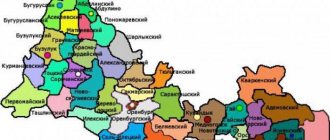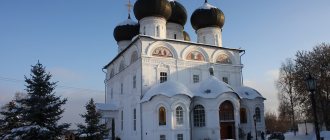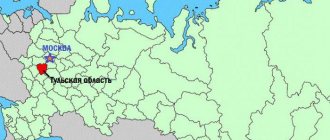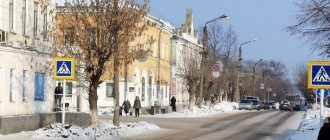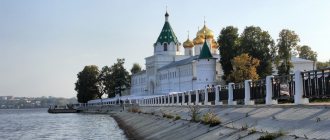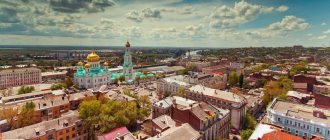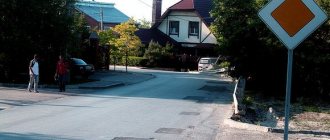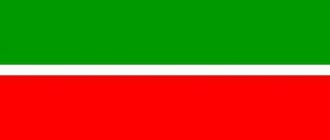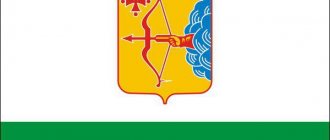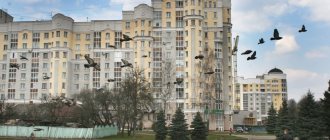In the Volgo-Vyatsky region in the Volga district is the Kirov region, whose population is 1,200 thousand people, of which 76% is urban. The list of cities in the Kirov region includes 18 settlements, the largest being the administrative center - Kirov. Founded in 1174 as the city of Vyatka, then it was renamed in 1457 to Khlynov, and in 1780 the previous name was returned. Only in 1934 did it begin to bear the name Kirov, where 500 thousand people currently live.
Content
- 1 Largest cities 500 thousand - 1 million people 1.1 Kirov
- 2.1 Kirovo-Chepetsk
- 3.1 Yaransk
Cities of the Kirov region: list by population
As mentioned earlier, the largest are Kirov and Kirovo-Chepetsk. 32 and 33 thousand people live in Vyatskie Polyany and Slobodskoye, respectively. Both settlements were founded in the 16th century and have a rich history.
Once upon a time, an Udmurt settlement was located on the site of Vyatskiye Polyany, and in addition to this people, Tatars and Mari lived. Then the village was formed in 1595, as the patrimony of the Vyatka Assumption Monastery, and only in 1942 it received the status of a city.
Slobodskoy was founded in 1489 and already became a city in 1780. It was founded as a fortress, as it is located on the bank of a river, where there is a cliff on one side, and on the other it is easy to track down enemies. The first buildings date back to the 13th century, but before the formation of the settlement the buildings were rebuilt several times. A little later, the Kremlin and the suburb where people lived, and then the Epiphany Monastery were built. The trading network developed very quickly and already in 1628 there were 35 shops and 40 trading establishments, and the construction of wooden churches proceeded quickly.
The list of cities in the Kirov region with a population of less than 30 and more than 15 thousand people includes only 4 cities: Sovetsk, Omutninsk, Yaransk, Kotelnich. The oldest is considered to be Kotelnich, which was created in 1181 and belongs to the list of small historical towns in Russia.
Small towns up to 20 thousand people
Yaransk
Population 16,283 people (2016).
Sovetsk (Kirov region)
There are other meanings of this name, see Sovetsk
Population 15,719 people (2016).
Sosnovka
Population 11,420 people (2016).
The city, among other things, is home to the Sosnovsky Shipyard.
Zuevka
Population 10,697 people (2016).
White Kholunitsa
Population 10,597 people (2016).
Population 10,461 people (2016).
Urzhum
Population 9,975 people (2016).
Nolinsk
Population 9,703 people (2016).
Kearse
Population 9,639 people (2016).
Malmyzh
Population 7,591 people (2016).
Orlov
Population 6,834 people (2016).
Murashi
Population 6,384 people (2016).
The smallest cities
The list of cities in the Kirov region is closed by small settlements such as Murashi and Orlov, where a little more than 6 thousand people live.
Despite the fact that Murashi was founded in 1895 as a station village, it does not have a rich history. Today, thanks to the presence of a railway station and timber processing factories, people continue to live in this place.
The city of Orlov was founded in the 12th-13th centuries and became famous for the fact that during the reign of Nicholas II it was a place where revolutionaries were exiled. In 1923, it was renamed in honor of the revolutionary Stepan Khalturin and given the name Khalturin, and only in 1992 the previous name was returned.
see also
- Kirov region
- Cities of Russia
| [ + ] Cities by regions of Russia | |
| Cities of the North-West (NWFD) | St. Petersburg (and its cities) • Leningrad region (historical Staraya Ladoga) • Arkhangelsk region • Vologda region • Kaliningrad region • Karelia • Komi • Murmansk region • Nenets Autonomous Okrug • Pskov region |
| Cities of the Volga region (Volga Federal District) | Bashkortostan • Volgograd region • Kalmykia • Kirov region • Mari El • Mordovia • Nizhny Novgorod region • Orenburg region • Penza region • Perm region • Samara region • Saratov region • Tatarstan • Udmurtia • Ulyanovsk region • Chuvashia |
| Cities of Southern Russia (SFD) | Sevastopol (including Inkerman) • Republic of Crimea • Adygea • Astrakhan region • Krasnodar region • Rostov region |
| Cities of the North Caucasus (NCFD) | Dagestan • Ingushetia • Kabardino-Balkaria • Karachay-Cherkessia • North Ossetia - Alania • Stavropol Territory • Chechen Republic |
| Cities of the Urals (Ural Federal District) | Kurgan region • Sverdlovsk region • Tyumen region • Khanty-Mansi Autonomous Okrug - Yugra • Chelyabinsk region • Yamalo-Nenets Autonomous Okrug |
| Cities of Siberia (Siberian Federal District) | Altai Republic • Altai Territory • Irkutsk Region • Kemerovo Region • Krasnoyarsk Region • Novgorod Region • Novosibirsk Region • Omsk Region • Tomsk Region • Tyva • Khakassia |
| Cities of the Far East (FEFD) | Amur Region • Buryatia • Jewish Autonomous Region • Trans-Baikal Territory • Kamchatka Territory • Magadan Region • Primorsky Territory • Sakha (Yakutia) • Sakhalin Region • Khabarovsk Territory • Chukotka Autonomous Region |
| see also | Cities of the DPR, LPR, Transnistria, South Ossetia • Regions of Russia • Cities of Russia |
Kirov is the capital of the Kirov region
The population in Kirov has shown annual growth over the past 8 years. The increase is mainly due to visitors of Russian nationality. This became possible thanks to the development of the industrial sector. The city produces rubber and plastic products, there is metallurgical and food production. A number of industrial enterprises operate on the territory.
The list of them is long, among them there is the famous “Kirovsky”. Due to the high population, traffic jams constantly occur. This settlement has a well-developed transport infrastructure, which is an undeniable advantage. However, it is not designed for a large number of people, so without government help it will not be able to expand further. The capital needs economic injections and support. Construction of new areas is currently underway, including:
- Chistye Prudy;
- Sunny Beach;
- Southern;
- Urvantsevo.
The last of the named areas caused a big scandal. Its main problem, according to most residents, is that the money was simply stolen. This is indicated by the current state of the area. From 2006 to 2013 Frames were erected for only 3 houses. Unscrupulous contractors carried out communications incorrectly, which greatly slowed down the implementation of the project. The authorities, however, are promising in every possible way to put the area in order so that it can become part of a large area called the South-Western region.
Geographical features
This region is located in the northeast of the Russian Plain. The size of the region along the meridian is 570 km, and in the latitudinal direction – 440 km. The distance from Kirov to Moscow is 896 km. The region is located within the Moscow time zone.
The Kirov region is characterized by hilly terrain. The northern part is significantly swampy. The climate is temperate, closer to cold. Severe frosts often occur in winter, and sudden cold snaps in summer. Precipitation amount is 500–700 mm per year. The region is characterized by a high level of forest cover.
List of settlements in the Kirov region according to the 1989 All-Union Population Census
This section contains the administrative-territorial division and a list of settlements in the Kirov region in 1989. In preparing this section, collections of the results of the 1989 All-Union Population Census, published by the Kirov Regional Statistics Department in 1990, were used.
From the 1st volume (“Population and its distribution by gender, age, marital status, number and size of families”), information was taken on the population size by districts and cities of regional significance, as well as information on urban settlements. From the 3rd volume (“Rural settlements”), information was taken on the population of village councils and rural settlements.
Typing and data processing were performed by the Rodnaya Vyatka portal. Read about the preparation of this publication in the editorial blog >>
.
Summary table of districts and cities of regional significance
To view information on village councils, click on the link with the name of the district.
| Item no. | Area | Center | Cities | P.g.t. | Selsovetov | Us. points | Sources
| ||||||||||||||||||||||||||||||||||||||||||||||||||||||||||||||||||||||||||||||||||||||||||||||||||||||||||||||||||||||||||||||||||||||||||||||||||||||||||||||||||||||||||||||||||||||||||||||||||||||||||||||||||||||||||||||||||||||||||||||||||||||||||||||||||||||||||||||||||||||||||||||||||||||||||||||||||||||||||||||||||||||||||||||||||||||||||||||||||||||||||||||||||||||||||||||||||||||||||||||||||||||||||||||||||||||||||||||||||||||||||||||||||||||||||||||||||||||||||||||||||||||||||||||||||||||||||||||||||||||||||||||||||||||||||||||||||||||||||||||||||||||||||||||||||||||||||||||||||||||||||||||||||||||||||||||||||||||||||||||||||||||||||||||||||||||||||||||||||||||||||||||
National population structure
In 2010, representatives of more than 100 different nationalities lived in the Kirov region. Russians make up over 90% of the residents of the Kirov region. In second place are the Tatars - up to 3%. The share of Ukrainians is 0.76%. It is somewhat higher among local national communities - Mari and Udmurts (2.6 and 1.2%, respectively). There are small numbers of Azerbaijanis, Armenians, Gypsies, Belarusians, Germans, Chuvashs and Moldovans. The presence of other nationalities is insignificant. For example, there are only 0.03% of Jews.
In many areas of the region, the share of Russians is more than 95%. For example, in Kirov there are from 96 to 97% of them. The fewest Russian residents are in the Mamlyzhsky district - 45.4%, which is largely due to the high number of Tatars.
The most rural nationality is the Mari. More than 70% of them live in rural areas.
Employment
According to official reports from the regional employment center, the employment situation in the region is stable. The unemployment rate is very low at only 1.1%. The total number of unemployed is 7,700 people. It is also noted that this figure is the lowest in the entire history of the center.
Employment levels vary greatly across areas. In 19 districts of the region, official unemployment exceeds the average by 2 times, and in five districts - by 3 times. The lowest unemployment rate is in Kirov, as well as in the Sovetsky, Urzhumsky, and Slobodsky districts.
In 2021, the number of vacancies provided by Kirov employers was 20 percent more than in the same period last year. The largest number of available vacancies (i.e., shortage of personnel) is observed in such areas as construction, mechanical engineering, information technology and agriculture.
There are also plenty of vacancies for doctors and engineers.
It is difficult to get a job in the Kirov region in such professions as lawyer, economist, accountant. Competition for 1 workplace in the listed specializations ranges from 5 to 18 people registered with the center.
